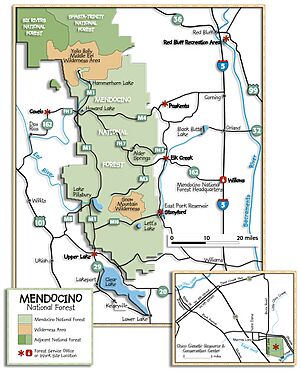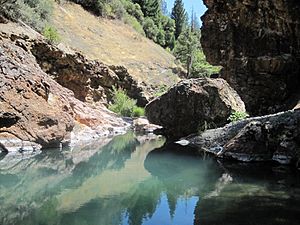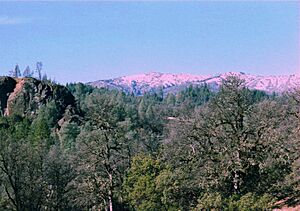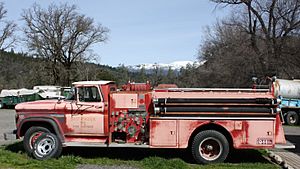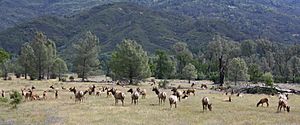Mendocino National Forest facts for kids
Quick facts for kids Mendocino National Forest |
|
|---|---|
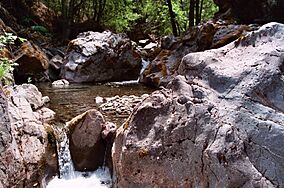
Rattlesnake Creek
|
|
| Nearest city | Willows and Covelo California |
| Area | 913,306 acres (3,696.02 km2) |
| Established | 1907 |
| Governing body | U.S. Forest Service / Department of Agriculture |
| Website | Mendocino National Forest |
The Mendocino National Forest is a huge natural area in northwestern California. It covers about 913,306 acres (3,696.8 square kilometers) of land. This forest is special because it's the only national forest in California that doesn't have a main paved road going through it.
It's a great place for many outdoor activities. You can go camping, hiking, mountain biking, or even paragliding. People also enjoy backpacking, boating, fishing, and hunting here. It's a wonderful spot for studying nature and taking photos. You can also explore the forest using off-highway vehicles.
The forest spreads across parts of six different counties in California. These include Lake, Glenn, Mendocino, Tehama, Trinity, and Colusa counties. The main office for the forest is in Willows, California. There are also local ranger offices in Covelo, Upper Lake, and Stonyford.
Contents
Exploring Wilderness Areas
The Mendocino National Forest is home to four special wilderness areas. These are places where nature is protected and kept wild.
- Sanhedrin Wilderness - 10,571 acres (42.78 square kilometers)
- Snow Mountain Wilderness — 60,076 acres (243.12 square kilometers)
- Yolla Bolly-Middle Eel Wilderness — 180,877 acres (731.98 square kilometers) (partly in other forests or on other land)
- Yuki Wilderness - 53,887 acres (218.07 square kilometers) (partly on other land)
The Sanhedrin and Yuki wilderness areas became official in 2006. This law also made the Yolla Bolly-Middle Eel and Snow Mountain wilderness areas even bigger.
Rivers, Lakes, and Hot Springs
Many rivers flow through the forest. These include the Eel River, Rice Fork Eel River, Middle Fork Eel River, Black Butte River, and Stony Creek (Sacramento River).
Lake Pillsbury is the biggest lake in the forest for fun activities. It covers about 2,280 acres (9.2 square kilometers). You can find boat ramps, camping spots, and resorts around the lake.
Letts Lake is smaller, about 35 acres (140,000 square meters) in size. It has hiking trails and campgrounds. It's also close to trails that lead into the Snow Mountain Wilderness.
Other lakes in the forest include Plaskett Lakes, Howard, Hammerhorn, Square, and Long Lakes. These are found in different parts of the forest.
History of the Forest
The idea for the Mendocino National Forest started a long time ago. In 1905, experts looked at public lands to decide which areas should be protected as a forest reserve. This work was led by Gifford Pinchot, who was the head of the United States Forest Service.
In 1907, President Theodore Roosevelt officially set aside this land as the Stony Creek Forest Reserve. A month later, it became part of the national forest system as the Stony Creek National Forest.
Over time, the forest's name changed a few times. Because it was hard to manage such a big area, parts of it were moved to other forests. In 1908, it was renamed the California National Forest.
A New Name for the Forest
To avoid confusion with the state of California, President Herbert Hoover changed the name again. On July 12, 1932, he signed an order renaming it the Mendocino National Forest.
Over the years, the forest had many offices and lookout points. Today, there are three main ranger districts. Some old guard stations are now used as "work centers," mainly for fire crews.
Wildfires in the Forest
The Mendocino National Forest has experienced several large wildfires. These fires are a natural part of the forest's ecosystem, but they can also be very destructive.
The famous Rattlesnake Fire happened here in 1953. Sadly, one Forest Service employee and 14 volunteer firefighters lost their lives. This tragedy led to big changes in how firefighters are trained and how they fight fires. There is a memorial for these firefighters overlooking Rattlesnake Canyon.
In 2001, the Trough Fire burned almost 25,000 acres (100 square kilometers) of the forest. This included land in the Snow Mountain Wilderness.
More recently, in 2018, the Mendocino Complex Fire burned a huge area. It covered about 284,000 acres (1,150 square kilometers) in the southern part of the forest. This was about one-third of the forest's total area. One firefighter died during this fire near Lake Pillsbury. The entire Snow Mountain Wilderness was burned in this event.
In 2020, the August Complex Fire started from many lightning strikes. This fire grew to be the largest wildfire in California's history, burning over 1,026,000 acres (4,150 square kilometers). It mostly burned through the Mendocino National Forest.
Amazing Wildlife
The tule elk is one of the largest land animals that naturally lives in California. Female elk can weigh up to 350 pounds (159 kilograms), and the largest males can weigh around 500 pounds (227 kilograms). These elk were almost completely hunted to extinction during California's gold rush days.
However, in the late 1970s, these animals were brought back to the Lake Pillsbury area. Since then, their numbers have grown steadily. By 2007, there were about 80 elk in the herd.
The elk live on the north shore of Lake Pillsbury. They enjoy eating wild clovers, grasses, and the green plants around the lake. The Mendocino National Forest is one of only two national forests in California where you can find tule elk.
Forest Vegetation
The Mendocino National Forest has many old trees. About 60,000 acres (240 square kilometers) of the forest are considered "old growth." This means the trees are very old and have been growing for a long time without much disturbance.
These old forests include different types of trees. You can find Coast Douglas-fir (Pseudotsuga menziesii var. menziesii), Ponderosa Pine (Pinus ponderosa), White Fir (Abies concolor), Tanoak (Lithocarpus densiflorus), and Pacific madrone (Arbutus menziesii).




